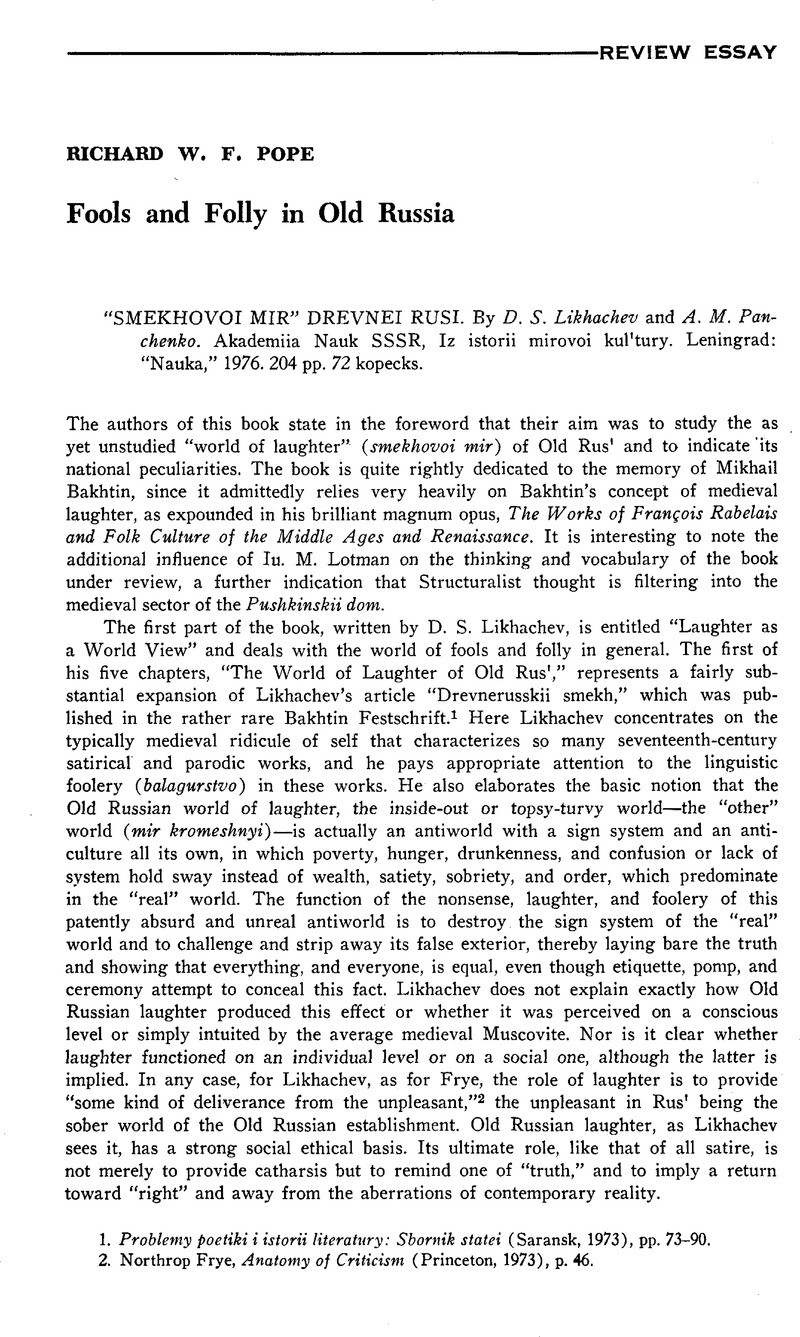No CrossRef data available.
Article contents
Fools and Folly in Old Russia
Published online by Cambridge University Press: 27 January 2017
Abstract

- Type
- Review Essay
- Information
- Copyright
- Copyright © Association for Slavic, East European, and Eurasian Studies. 1980
References
1. Problemy poetiki i istorii literatury: Sbornik statei (Saransk, 1973), pp. 73-90.
2. Northrop Frye, Anatomy of Criticism (Princeton, 1973), p. 46.
3. The chapter was published separately, with only minor stylistic changes, in Russian Literature, 5, no. 4 (October 1977): 373-87.
4. B., Swain, Fools and Folly during the Middle Ages and the Renaissance (New York, 1932Google Scholar).
5. E., Welsford, The Fool: His Social and Literary History (Gloucester, Mass., 1935Google Scholar).
6. B., Konneker, Wesen und Wandlung der Narrenidee im Zeitalter des Humanismus: Brant, Mtimer, Erasmus (Wiesbaden, 1966)Google Scholar.
7. J., Lefebvre, Les Fols et la folic: Stude sur les genres du comique et la creation litteraire en Allemagne pendant la Renaissance (Paris, 1968)Google Scholar.
8. W., Willeford, The Fool and his Sceptre: A Study in Clowns and Jesters and their Audience (Evanston, 111., 1969)Google Scholar.
9. D. S., Likhachev and A. M., Panchenko, “ Smekhovoi mir ” Drevnei Rust (Leningrad, 1976), p. 25 Google Scholar.
10. Ibid., p. 57.
11. Ibid., p. 59.
12. Swain, , Fools and Folly, pp. 3–5Google Scholar.
13. Curtius, Ernst Robert, “Jest and Earnest in Medieval Literature,” in European Literature and the Latin Middle Ages, trans. Willard R. Trask (New York, 1963), pp. 417–35 Google Scholar.
14. Lefebvre, , Les Fols et la folie, p. 21 Google Scholar.
15. Russell Zguta, “Skomorokhi: The Russian Minstrel-Entertainers,” Slavic Review, 31, no. 2 (June 1972): 297-313. See also A., Belkin, Russkie skomorokhi (Moscow, 1975Google Scholar).
16. Much of the material in this chapter is also found in the chapter on Avraamii/Afanasii ( “Inok Avramii, on zhe iurodivyi Afanasii” ) in Panchenko, A. M., Russkaia stikhotvornaia kul'tura XVII veka (Leningrad, 1973), pp. 82–102 Google Scholar.
17. But see Natalie Challis and Horace W. Dewey, “The Blessed Fools of Old Russia,” Jahrbiicher fur Geschichte Osteuropas, n.s., 22, no. 1 (1974): 2–5Google Scholar.
18. The chapter is a reworking and expansion of his article (A. M. Panchenko, “Iurodstvo kak zrelishche” ) which appeared in Akademiia nauk SSSR, Institut russkoi literatury, Otdel drevnerusskoi literatury, Trudy, vol. 29: Voprosy istorii russkoi srednevekovoi literatury (Leningrad, 1974), pp. 144-53.
19. On Christ's foolishness, see Willeford, , The Fool and his Sceptre, pp. 231–33Google Scholar.
20. Panchenko, Likhachev and, “Smekhovoi mir” Drevnei Rusi, p. 156 Google Scholar.
21. Cf. Natalie Challis and Horace W. Dewey, “Byzantine Models for Russia's Literature of Divine Folly (Jurodstvo),” in Benjamin, Stolz, ed., In Honor of James Ferrell (Ann Arbor, 1977), pp. 43–44 Google Scholar.
22. See Welsford, The Fool, chapter 4 ( “Origins: The Fool as Poet and Clairvoyant” ).
23. See Thompson, E, “Russian Holy Fools and Shamanism,” in American Contributions to the Eighth International Congress of Slavists, vol. 2: Literature, ed. Victor Terras (Columbus, Ohio, 1978), pp. 691–706 Google Scholar.
24. After crowning Socrates, Alcibiades also points out that Socrates is an actor who feigns ignorance but is wise, that he only seems weak whereas he actually has great endurance, and that even though he appears to speak ridiculously, using curious phrases that invoke laughter among the foolish, in actual fact his words make profoundly good sense.
25. Panchenko, Likhachev and, “Smekhovoi mir” Drevnei Rusi, p. 94Google Scholar. For divine folly in Western literature, see, for example, F. Vandenbroucke,” ‘Fous pour le Christ': En Occident,” in Dictionnaire de spiritualite ascetique et mystique: Doctrine et histoire, vol. 5 (Paris, 1964), columns 761-70.
26. Swain, , Fools and Folly, pp. 36-38, 199-200Google Scholar.
27. Ibid., p. 40. This occurred in the West at exactly the same time as it did in Russia.
28. Panchenko, Likhachev and, “Smekhovoi mir” Drevnei Rusi, p. 93Google Scholar.
29. George, Fedotov, The Russian Religious Mind, vol. 1 (Cambridge, Mass., 1946Google Scholar).
30. Fedotov, G. P., Sviatye Drevnei Rusi, X-XVII st. (New York, 1959), chapter 13Google Scholar.
31. See, for example, the bibliography following Spidljk, T, “'Fous pour le Christ': En Orient,” in Dictionnaire de spiritualite, vol. 5Google Scholar, columns 760-61. Reference Books of 1978-79: A Selection Librarians in the Slavic and East European Division of the University of Illinois Library at Urbana-Champaign have selected and annotated the reference books for this sixth annual listing. Available Library of Congress entries and card numbers have been added to facilitate access to the books in libraries. Annotations are signed with the initials of the reviewers.1 GENERAL Slavianovedenie v dorevoUutsionnoi Rossii: Biobibliograficheskii slovar'. Edited by V. A. D'iakov et al. Moscow: “Nauka,” 1979. 426 pp. 2.20 rubles. LC 79-378559. Although containing short sections on the history and development of Slavic studies in Russia, the greatest portion of the text of this book is devoted to signed articles on the Slavicists, historians, journalists, and travel writers of the mideighteenth century to 1917 who contributed to the field. Most entries are for Russian scholars, but foreign Slavicists who worked within the Russian Empire are also included. For those whose main body of work was completed in the pre- Revolutionary period, there are fairly detailed entries discussing the author's place and influence. Those whose main work was accomplished after 1917 are treated in less detail. In addition to the biographical material and bibliographies of works by and about an author, there is also a listing of pertinent archival sources. In most cases the articles are much more substantial than those found in more general historical and literary encyclopedias. A name index is included.—JEP.




